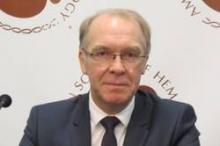NEW ORLEANS – For patients with newly diagnosed multiple myeloma who are not eligible for stem cell transplants, continuous treatment with lenalidomide and low-dose dexamethasone was associated with significant overall survival and progression-free survival benefits, compared with melphalan-prednisone-thalidomide.
"Overall, we should congratulate [the investigators] for having a new standard of care that is active, convenient, and with excellent tolerability," said invited discussant Dr. Jesús San Miguel from the cancer center at the Hospital Universitario de Salamanca, Spain.
Initial results from the phase III FIRST trial (Front-Line Investigation of Revlimid/Dexamethasone vs. Standard Thalidomide) showed that lenalidomide (Revlimid [RD]) plus low-dose dexamethasone used until disease progression was associated with a median progression-free survival (PFS, the primary endpoint) of 25.5 months, compared with 20.7 months for patients treated with the same combination for 18 cycles over 72 weeks (RD18), and 21.2 months for patients treated with melphalan-prednisone-thalidomide (MPT) for 12 cycles over 72 weeks, reported Dr. Thierry Facon of the Service des Maladies du Sang, Hôpital Claude Huriez and CHRU Lille, France.
At the first interim analysis, patients treated with continuous RD had better overall survival than patients treated with MPT, with a hazard ratio favoring RD of 0.78 (P = .0168). However, there were no significant differences in overall survival between the RD and RD18 groups or between the RD18 and MPT groups, Dr. Facon said at the American Society of Hematology annual meeting.
The FIRST trial investigators enrolled 1,623 patients aged 65 years or older from 246 centers in 18 countries in North America, Europe, Asia, and Australia/New Zealand. Patients were randomly assigned to either continuous RD (535), RD18 (541), or MPT (547). Median follow-up as of May 24, 2013, was 37 months.
Continuous RD offered significantly better PFS, compared with either RD18 or MPT. At 3 years, 42% of patients on continuous RD remained progression free, compared with 23% each in the other two groups. The hazard ratio for continuous RD vs. MPT was 0.72 (P = .00006), and vs. RD18 was 0.70 (P = .00001). There was no significant difference in progression-free survival between RD18 and MPT.
Estimated 4-year overall survival rates were 59.4% in the continuous RD group, 55.7% in the RD18 group, and 51.4% in the MPT group.
"RD was superior to MPT across all other efficacy secondary endpoints," Dr. Facon said in the plenary session. Those secondary endpoints included response, duration of response, time to response, time to treatment failure, time to second-line anti–multiple myeloma therapy, time to progression, safety, and quality of life.
Both versions of the RD regimen were generally comparable to MPT in safety profile, although infections were more frequent with RD, and peripheral sensory neuropathy was more frequent with continuous RD (1.1% vs. 0.4% for the other two regimens).
The incidence of second primary malignancies was lower in both RD groups, consisting of one case each of acute myeloid leukemia and myelodysplasia in each group, compared with four cases of acute myeloid leukemia, six of myelodysplasia, and two cases of myelodysplasia converting to acute myeloid leukemia in the MPT group.
Current treatment approaches for elderly, newly diagnosed patients with multiple myeloma include MPT, which is associated with a PFS of 20.3 months; and bortezomib (Velcade), melphalan, and prednisone (VMP), with a PFS of 18.3 months. MPT and VMP are the preferred regimens recommend by the National Comprehensive Cancer Network for patients who are ineligible for stem cell transplants because of age or other factors, Dr. Facon noted. Typically, drug therapy in this patient population has had a fixed duration because of f concern for toxicities associated with long-term therapy.
Dr. San Miguel noted that the excellent results were achieved without the use of an alkylating agent such as melphalan or cyclophosphamide, which might lead some clinicians to question whether alkylating agents still have a role in this population. He pointed out, however, that the study was not designed to answer that question. To do so, it would be necessary to compare RD with and without an alkylator for the same treatment duration.
"Probably the most challenging question is the duration of the lenalidomide treatment. The data indicate that the best option is to treat until progression. Nevertheless, it would be interesting to know the outcome according to response, because it could be that in patients taking lenalidomide and dexamethasone for 1 year or [1 1/2 years] will achieve a complete response with prolonged disease stability. Additional treatment may not add too much, and this could contribute to increased cost and toxicities of unnecessary prolonged treatment," he said.


